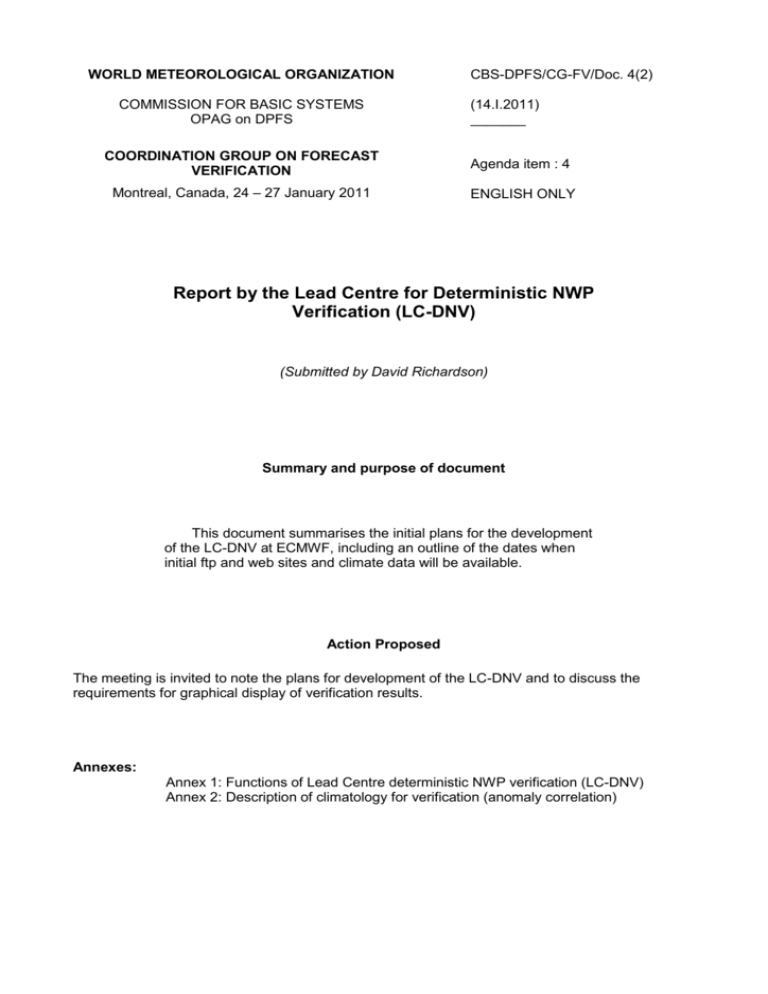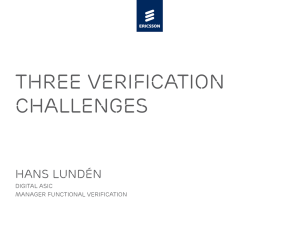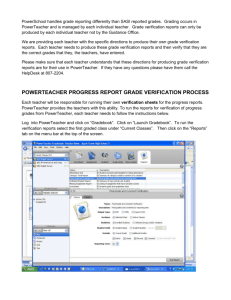Report by the Lead Centre for Determinist NWP verification
advertisement

WORLD METEOROLOGICAL ORGANIZATION COMMISSION FOR BASIC SYSTEMS OPAG on DPFS CBS-DPFS/CG-FV/Doc. 4(2) (14.I.2011) _______ COORDINATION GROUP ON FORECAST VERIFICATION Agenda item : 4 Montreal, Canada, 24 – 27 January 2011 ENGLISH ONLY Report by the Lead Centre for Deterministic NWP Verification (LC-DNV) (Submitted by David Richardson) Summary and purpose of document This document summarises the initial plans for the development of the LC-DNV at ECMWF, including an outline of the dates when initial ftp and web sites and climate data will be available. Action Proposed The meeting is invited to note the plans for development of the LC-DNV and to discuss the requirements for graphical display of verification results. Annexes: Annex 1: Functions of Lead Centre deterministic NWP verification (LC-DNV) Annex 2: Description of climatology for verification (anomaly correlation) CBS-DPFS/CG-FV/Doc. 4(2), p. 2 Report by the Lead Centre for Deterministic NWP Verification (LC-DNV) 1. Introduction and summary Following CBS’ request for the establishment of a Lead Centre for Deterministic NWP Verification (LC-DNV), as has been done for EPS and LRF verification, the CG-FV developed (at its first meeting) a list of functions expected from such Lead Centre. These functions were agreed by CBS-Ext.(10) in November 2010. ECMWF offered to act as LC-DNV; CBS-Ext.(10) agreed that ECMWF met the requirement as included in the list of Lead Centre functions and recommended its designation. The list of functions for the LC-DNV is provided in Annex 1. ECMWF will undertake all the mandatory functions of the LC-DNV. These will be implemented during 2011. An outline of the required developments and provisional dates is provided below. 2. ftp and web sites ECMWF will establish an ftp site and a web site for the LC-DNV. The ftp site will be password protected. It will be used for the participating centres to deposit their verification statistics. The climate fields to be used for verification (anomaly correlation) will be provided by ECMWF on this ftp site, as will the current list of radiosonde stations to be used in the verification. The web site will contain the relevant documentation and contact details as well as graphical displays of the verification results. Initially the verification displays will be password protected while the products are developed. Once the site is ready, the access needs to be agreed (does CG-FV do that or can participating centres determine this); can either be public access (LC-LRFVS) or available to WMO members only (password protected). For initial development purposes the currently exchanged verification statistics will be used. Producing centres will be encouraged to send the scores in the new file format, see below. It is planned that the ftp site and initial information web pages will be available by the end of February. 3. Climatology The required climate fields will be provided on the LC-DNV ftp site. These will initially be the daily climate mean fields that are required to compute the anomaly correlation in the verification against analyses. They will be provided in grib format on 1.5 x 1.5 latitude longitude grid, as required by the new verification procedures. These will be available via the ftp site before the end of February for users to retrieve. Relevant documentation will be included (for information, a short draft document describing the climate is included in annex 2). Complementary climate fields including standard deviation and quantiles of the climate distribution are also produced. These are not required for the deterministic verification, but will be needed for the EPS verification. They may be made available in the same way in future. 4. Verification data and formats Currently monthly means of scores of forecasts verifying in the given month are exchanged. The revised CBS procedures propose to modify this practice and to start exchanging daily values of scores. The data will be still sent in monthly batches but the monthly means would by computed by LC-DNV. The current verification scores are exchanged by email in a fixed ascii format. We note that EPS and LRF verification exchanges also use ascii. However, we propose to change to use a CBS-DPFS/CG-FV/Doc. 4(2), p. 3 more robust format, e.g. XML or JSON. It is proposed to develop, test and agree the exchange format by April(?). Views of the meeting are welcome. 5. Display of verification results We will develop a range of graphical displays of the verification results from the participating centres. Initially we will use the currently exchanged scores to develop the displays. The meeting is invited to discuss and propose appropriate graphical displays. Depending on the transition arrangements for the introduction of the new verification procedures, we can either introduce the new website with the revised score or (if that will be some time) release first with the current scores. It will be possible to show both sets in parallel for a transition period. Development of the graphical display of scores will be done with the aim of providing an initial set of results by June (?) 4 Other lead centres For information it is worth looking at the other Lead Centres for verification. The Lead Centre for EPS verification is maintained by JMA: http://epsv.kishou.go.jp/EPSv/# One of the main problems that they have had is the slow response of EPS centres in providing their verification statistics. The Lead Centre for Long-range forecast verification is jointly managed by the Australian Bureau of Meteorology and the Meteorological Service of Canada: http://www.bom.gov.au/wmo/lrfvs/index.html ECMWF also maintains a verification inter-comparison site for ocean wave forecasts on behalf of the WMO-IOC Joint Technical Commission for Oceanography and Marine Meteorology (JCOMM): http://www.ecmwf.int/products/forecasts/d/charts/medium/verification/wave/intercomparison/ CBS-DPFS/CG-FV/Doc. 4(2), p. 4 Annex 1 FUNCTIONS OF LEAD CENTRE FOR DETERMINISTIC NWP VERIFICATION (LC-DNV) The Lead Centre functions include creating and maintaining a website for Deterministic NWP verification information, so that potential users will benefit from a consistent presentation of the results. The goal is to provide verification information on the NWP products of GDPFS participating centres for forecasters in the NMHSs and help the GDPFS Centres improve their forecasts. Congress urged all Members to actively participate in that activity as either users or producers of Deterministic NWP verification information to assure the best use of the available products. Note: * The “deterministic NWP” refers to single integrations of NWP models providing products defining single future states of the atmosphere (as distinct from ensemble prediction systems where multiple integrations provide a range of future states). The purpose of the LC-DNV shall be to create, develop and maintain the website to provide access to the Deterministic NWP verification information. The choice of verification statistics, the content of the documentation, the information on interpretation and use of the verification data will be determined and revised by the CBS. The address of the website is …………….. 1. The LC-DNV shall: a) Provide the facility for the GDPFS participating Centres to automatically deposit their verification statistics in the agreed format, and give all participating Centres access to these verification statistics b) Maintain an archive of the verification statistics to allow the generation and display of trends in performance c) provide specifications defining the format of the data to be sent by the GDPFS participating Centres to the LC-DNV (specification to be defined in consultation with the CG-FV) d) Monitor the received verification statistics and consult with the relevant participating centre if data is missing or suspect e) Provide on its website access to the standard procedures required to perform the verification f) Provide access to standard data sets needed to perform the standard verification, including climatology and lists of observations and keep this up to date according to CBS recommendation g) Provide on its website o consistent up-to-date graphical displays of the verification results from participating Centres through processing of the received statistics o relevant documentation and links to the websites of GDPFS participating Centres; o contact details to encourage feedback from NMHSs and other GDPFS Centres on the usefulness of the verification information 2. The LC-DNV may also: (a) Provide access to standardized software for calculating scoring information. CBS-DPFS/CG-FV/Doc. 4(2), p. 5 Annex 2 DESCRIPTION OF CLIMATOLOGY FOR VERIFICATION (ANOMALY CORRELATION) The climatology data proposed to be used by all global centres providing their scores to LC DNP is so called daily climatology. The daily climatology represents a derived product of the ECMWF reanalysis dataset. It provides a best estimate of climate characteristics for the given day of the year in the form of mean, standard deviation, and other statistics describing climate distribution in grid points of a global grid. The primary application of the daily climatology is the evaluation of anomalies of atmospheric parameters, both in forecast fields (e.g. for anomaly probability prediction by EPS) and in analyses. A good daily climatology is essential for computing of anomaly-based verification scores, both deterministic (anomaly correlation coefficient, mean anomaly of forecast etc.) and probabilistic (Brier score, ranked probability score, skill scores etc.). The presence of detailed distribution characteristics of the daily climatology makes it also suitable to serve as a reference forecast method for skill scores calculations. At ECMWF the methodology for construction of the daily climatology has been developed and tested for ERA-40 dataset (Jung and Leutbecher, 2008) on the period 1979-2001. Currently the new daily climatology based on 1989-2008 analyses of ERA-Interim has been built well. It is used by the new operational verification system at ECMWF and it is now available for other users' applications. ERA Interim daily climatology (ERAI-DACL) consists of horizontal fields of statistical characteristics of atmospheric parameters at a given time and day of a year. For a given parameter and level and a given day of a year and time there are fields of mean (a field of the filtered mean values of the parameter valid at a given hour and on a day of a year computed from the sampling 20-years period), standard deviation (idem for standard deviation), minima and maxima (idem for extreme values) quantiles (the terciles and selected percentiles of the distribution of the parameter during the sampling period). The ERAI-DACL fields are available from ECMWF in the GRIB-1 format. The upper-air parameters are available at 00 and 12 UTC network times and the surface and screen-level parameters at times 00, 06, 12, 18 UTC. A special subset of the ERAI-DACL dataset has been prepared for purposes linked to the activities of LC DNV. The fields of the meteorological parameters which verification scores are computed for have been postprocessed to the regular latitude-longitude grid with the grid step 1.5°. Only fields of the climatology mean are provided in the LC DNV subset. Methodology for daily climatology The methodology for construction of the daily climatology has been developed and tested on ERA-40 dataset (Jung and Leutbecher, 2008) and later applied on ERA-Interim data. Here, we compute climatological statistics which depend on location and the day of the year. The climatology consists of daily fields of the mean, standard deviation of anomalies, and quantiles of anomalies. The climatology is based on ERA-Interim analyses, which are expected to provide the most accurate available, consistent, long-term description of the atmosphere. The climate is based on the 20 years 1989-2008. For each day of the year, statistics are based on a 61-day window centred on the day of interest. The statistics are computed with weights which are maximum at the window centre and gradually decrease to zero at ±30 days. Thus, 20×61 = 1220 dates contribute to the climate statistics of one day. Variable weights are superior to constant weights in terms of resolving the annual cycle and in filtering high-frequency sampling uncertainty. The climate of a particular wavenumber band is computed from the filtered analyses. CBS-DPFS/CG-FV/Doc. 4(2), p. 6 The climatological statistics is computed from analyses for NY = 20 years. For day ν in month μ, the climatology is computed from data N1/2 days before the day to N1/2 days after. The choice of N1/2 has to seek a compromise between well resolving the annual cycle and a sufficient sample size. It was chosen N1/2 = 30. Due to the variable weights this fairly large window still resolves the annual cycle well. In Jung and Leutbecher, 2008, climatologies were also computed with N1/2 = 10 and 5. They still showed some noise on time scales smaller than one month but did not seem to contain additional information about the annual cycle. The dates are arranged in a periodic manner in order to obtain a continuous annual cycle without a jump at New Year. It is convenient to express the dates in terms of Julian day number. Let JYMD(jY,jM,jD) denote the Julian day number for day jD in month jM and year jY. The climate is computed from data between 1 Jan 1989 and 31 Dec 2008. In order to formulate the periodicity, we define J0 = JYMD(1989,1,1) = 2447528 and ΔJ = JYMD(2009,1,1) -J0 = 7305. Any date J is mapped to date (1) which always falls between 1 Jan 1989 and 31 Dec 2008. The climatology for day ν and month μ is computed from dates where index j = -N1/2, -N1/2+1,..., N1/2 specifies the distance in days from the centre of the data window and index k = 1,2,...,NY specifies the year. Thus, the total sample size is NY(2N1/2+1) = 1220. The statistics are computed with a weighted average designed to damp highfrequency sampling uncertainties. The weights depend on the distance j from the centre of the window (2) Let xjk denote data at date Djk. Then, the mean and variance are computed as (3) (4) where denotes the anomaly about the climatological mean. The probability distribution of anomalies about the mean is constructed with the aid of the family of distributions (5) where ϵ is considered to be a small positive number and (6) The CDF is defined at the data values (7) by integrating pε and then taking the limit ε→0: (8) If the weights wj were all equal, the CDF would assume the values given by Hazen's plotting positions (cf. Wilks, 2006). For intermediate data points x', the CDF is defined by linearly interpolating the probability between the closest data points enclosing x'. Therefore, quantile values CBS-DPFS/CG-FV/Doc. 4(2), p. 7 are obtained through linear interpolation of the CDF at the data points. Note, that the definition of the CDF is consistent with the definition of the variance of anomalies in the sense that will have the variance given by Eq. (4). Statistics of the wave parameters (the significant wave height and the mean wave period) require extra care as due to the variable extent of the sea-ice there are no wave analysis data at sea points near polar regions in some years. Therefore only points where there are analysis values of at least 25% of the full time window available are taken into consideration; otherwise the grid-point value is set as missing. References: Jung T, Leutbecher M. 2008. Scale-dependent verification of ensemble forecasts. Quart. J. Roy. Meteor. Soc. 134: 973-984.







